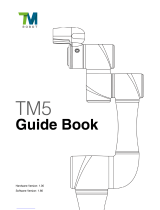
Table of Contents
vi TP3 Rev.18
8.1.1 Available USB Flash Drive .............................................................. 26
9. Warning Sound (Beep) 26
Operation
1. Teaching Procedure 29
1.1 Jog Operation ........................................................................................... 30
1.1.1 Step Jog Operation ...................................................................... 30
1.1.2 Continuous Jog Operation ........................................................... 30
1.2 Teaching ................................................................................................... 30
1.3 Direct Teaching ......................................................................................... 31
1.3.1 Direct Teaching of SCARA Robot ................................................ 31
1.3.2 Direct Teaching of Force Sensor .................................................. 31
2. Common Functions 33
2.1 Current Robot ........................................................................................... 34
2.2 Status Bar ................................................................................................. 34
2.3 Tool ........................................................................................................... 35
2.3.1 I/O Monitor .................................................................................... 35
2.3.2 Robot 3D View ............................................................................. 36
2.3.3 Brake Setting ................................................................................ 38
2.3.4 Command Window ....................................................................... 39
2.3.5 Task Manager ............................................................................... 40
2.3.6 Force Monitor ............................................................................... 41
2.4 Sub Menus ................................................................................................ 42
2.4.1 Change Jog Key ........................................................................... 42
2.4.2 System History ............................................................................. 42
2.4.3 Motor ............................................................................................ 43
2.4.4 Reset ............................................................................................ 43
2.5 Error Messages ........................................................................................ 44
3. TEACH/T1 Mode 45
3.1 Control Panel ............................................................................................ 46
3.1.1 Motors .......................................................................................... 46
3.1.2 Free Joints .................................................................................... 47
3.1.3 Command Buttons ....................................................................... 47
3.2 Jog & Teach .............................................................................................. 48
3.2.1 Mode............................................................................................. 49
3.2.2 Speed ........................................................................................... 49
3.2.3 Coordinate System ....................................................................... 49
3.2.4 Current Position ........................................................................... 50
3.2.5 Current Arm Orientation ............................................................... 50
3.2.6 Jog Distance ................................................................................. 50
3.2.7 Registering the Robot Position .................................................... 51
3.2.8 Command ..................................................................................... 51
3.2.9 Jog Key Guide .............................................................................. 51



























